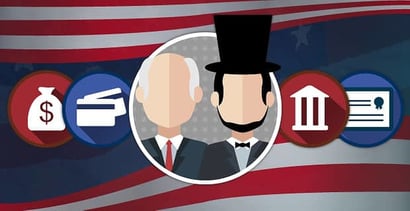

President’s Day is a time to reflect on the accomplishments and leadership of our past commanders-in-chief. We remember their lives, their words and how they shaped America during their tenure in the Oval Office.
To help you understand the protections and rights you have as a citizen in the consumer credit market, we highlighted several presidents who passed significant consumer finance legislation during their time in office.
Many of these laws stand to this day and afford everyday consumers like you and me unique financial protections. You’ll find many of these laws allow citizens to take on debt and engage the economy on a level playing field, while also protecting us from predatory and dishonest business practices.
1. Abraham Lincoln
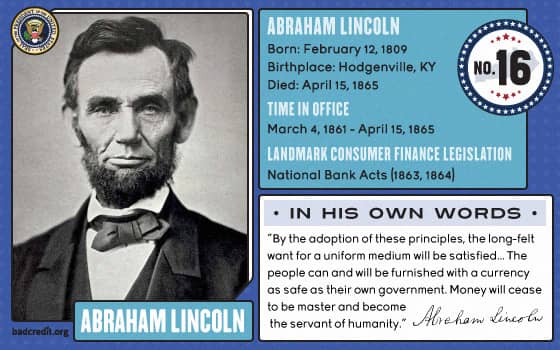
Generally regarded as one of the greatest presidents ever, Abraham Lincoln navigated the United States through the bloody chaos of the Civil War and permanently ended slavery in the United States.
The economy prior to his presidency was not unlike our own around the time of the 2006-7 mortgage crisis — the development of railroads catalyzed real estate speculation and sale in the midwest, which ultimately burst, causing a brief panic in 1857.
National Bank Acts (1863, 1864) — Financing the Union’s war efforts was a tricky and difficult task, which prompted the Federal Government to create a national banking system and currency (a majority of financial institutions were state-charted and issued their own currencies up to that point).
The act helped address “wildcat” banks that, at the time, were issuing loans to fund land speculation. Since expansion west was a largely unregulated affair, a national banking system and currency helped stabilize the mid-19th century economy.
“Lincoln-era banking legislation had two key components,” said Albany Law School Associate Professor of Law Raymond Brescia. “One, they occurred over time in multiple pieces of legislation, and two, he utilized the power of taxes to discourage, and ultimately end, banking practices that destabilized the American economy.”
2. Woodrow Wilson
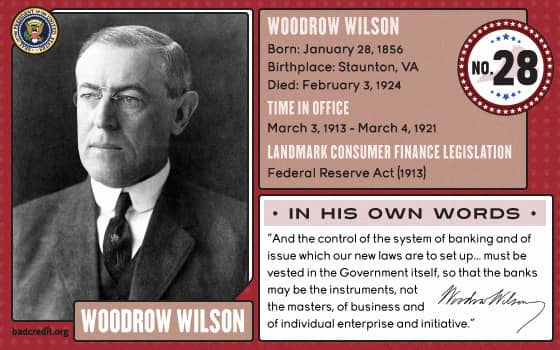
President Wilson provided leadership for the nation during his second term of office when the United States was dragged into World War I, amid fears of Germany’s submarine technology and possible alliance with Mexico.
However, he was also remembered for helping establish the Federal Reserve, arguably the nation’s most important and powerful economic organization.
Federal Reserve Act (1913) — This act established the Federal Reserve, or “the Fed”, as the central banking authority in the United States. While independent of the government itself, it plans and implements the nation’s macroeconomic policies.
Its scope of powers is broad and complex, but generally, the Fed strives to stabilize unemployment, inflation/deflation, and interest rates, and prevent economic panics.
3. Franklin Delano Roosevelt
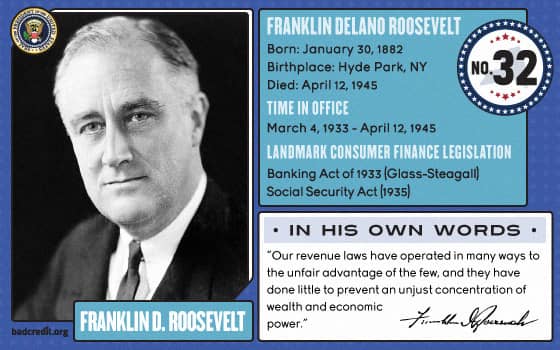
President Roosevelt had the difficult task of rebuilding the nation following the catastrophic stock market crash of 1929 that plunged the United States into the Great Depression — not to mention leading the nation through World War II as well.
His economic and social reforms through his New Deal program were some of the most monumental in the history of the United States, affording citizens new consumer and welfare protections.
The Banking Act of 1933 (Glass-Steagall) — The Banking Act of 1933, also known as the Glass-Steagall Act, prohibited banks from participating in both commercial banking and investing banking, requiring them to choose one specialty over the other, in an effort to prevent another crash similar to the one that led to the Great Depression.
The act also created the Federal Deposit Insurance Corporation (FDIC), which provides deposit insurance to banks. This means that, if the bank holding your money fails and cannot honor your withdrawal requests, your money is guaranteed (up to $250,000 today) by the full faith and credit of the U.S. government.
“[Deposit insurance] is probably the single most important piece of consumer protection legislation ever passed in our country,” said Ann Graham, Professor of Law at Hamline University and former Regional Counsel with the FDIC. “My parents were children of the depression. They vividly remember their families losing money… [The Banking Act of 1933] ushered in 50 years of banking system stability and gave consumers reason to trust the system, take money from underneath their mattresses and feel safe about putting it in the banking system.“
(Note: President Clinton would later repeal Glass-Steagall in 1999 via the Gramm–Leach–Bliley Act)
The Social Security Act (1935) — During the depression, more than half of senior citizens were living below the poverty line. This legislation set up America’s system of social security, which provides financial assistance initially to the retired elderly and later other classes of citizens.
Social security benefits receive their funding through a payroll tax paid by both workers and their employers. However, with the national population growing exponentially and citizens living longer thanks to advances in medicine, many wonder how the government will be able to fund social security in the future.
4. Lyndon B. Johnson
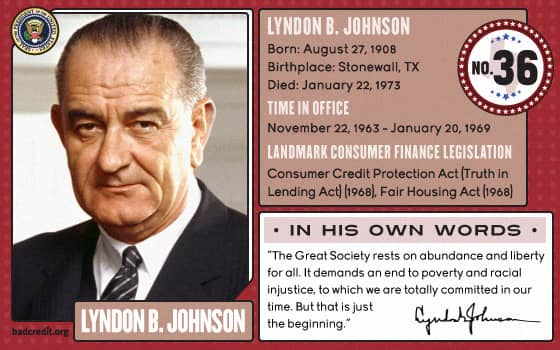
President Johnson enacted some of the most iconic social and welfare legislation in the history of the United States, overseeing the Civil Rights Acts of 1964 and ’68, as well as the beginning of the “War on Poverty.”
The ’60s were a monumental time of progress for civil rights in the United States, so it’s no surprise to see it bring about legislation like…
The Consumer Credit Protection Act (Truth in Lending Act) (1968) — The CCPA addresses several issues related to consumer credit, including wage garnishment — for example, employees can no longer be fired due to wage garnishment for any one debt. The law also sets limits on how much of their income can be garnished.
Another integral part of the CCPA was the Truth in Lending Act, which gives consumers a number of protections from various misleading and unfair credit billing practices. For example, it gives consumers a three-day window to back out of loan agreements without losing money.
The Fair Housing Act (1968) — A part of the historic Civil Rights Act of 1968, the Fair Housing Act forbids sellers and landlords from discriminating against prospective renters and buyers based on protected class characteristics such as race, sex, marital status, national origin, religion and others.
Although the law has been on the books for nearly four decades, critics say there are still many cases of housing discrimination every year; many of these cases may be an unintended consequence of using big data algorithms generated from credit reporting bureaus.
5. Richard Nixon
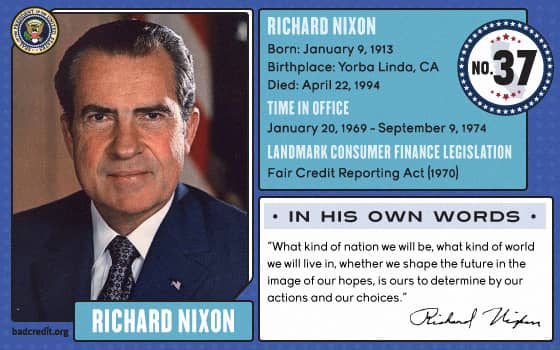
President Nixon was one of the most enigmatic and cunning figures in the history of American politics. A brilliant orator and political savant, he reinvigorated relations with China, began scaling back operations and Vietnam, helped reach nuclear agreements with the Soviet Union and gave a curious speech about a dog named Checkers.
However his legacy remains overshadowed by the Watergate Scandal, so it’s no surprise you may not remember him passing the…
Fair Credit Reporting Act (1970) — The FCRA is essential to your right as a consumer to see what’s on your credit report and dispute any errors you may find. It also outlines a number of regulations and ground rules credit reporting agencies must follow.
For example, FCRA mandates that reporting agencies must provide information about a consumer when he or she requests it and also set maximum limits for how long negative marks can stay on credit reports (for more, read 5 Penalties That Will Haunt Your Credit Reports for Years).
The FCRA was later amended in 2003 by the Fair and Accurate Credit Transactions Act to allow users to get that credit report information for free through annualcreditreport.com.
6. Gerald Ford

President Ford’s time in the White House was brief, taking over as President Nixon and Vice President Spiro Agnew retreated from Washington following the Watergate Scandal.
President Ford took over the presidency around the end of the lengthy and unpopular Vietnam War, and was tasked with addressing issues of inflation and recession.
The Fair Credit Billing Act (1974) — The FCBA acts as an amendment to the related Truth in Lending Act and adds a number of consumer protections designed to prevent dishonest or unfair billing practices.
It seems like these things should be a no-brainer, but the FCBA protects consumers against charges on credit cards that were incorrect, resulted in a faulty or damaged product, and others. It also helped set up a procedure for consumers to dispute their charges.
Equal Credit Opportunity Act (1974) — One of the most important laws in consumer credit, the ECOA expressly forbids creditors from discriminating against applicants based on protected classes, such as age, sex, race, national origin, marital status and more.
Likewise, creditors can’t discriminate based on whether the applicant receives funds from the government such as welfare, social security, VA benefits, alimony and more.
7. James “Jimmy” Carter
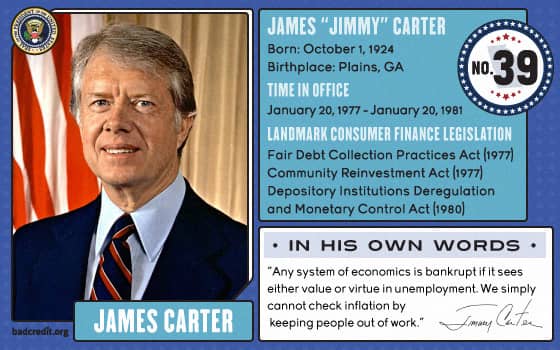
President Jimmy Carter is largely associated with his humanitarian efforts and social policies, establishing the Departments of Energy and Education while in office and later becoming an essential figure in the Habitat for Humanity charity.
While President Carter had only one term in the Oval Office, he managed to pass a series of key consumer finance protections:
The Fair Debt Collection Practices Act (1977) — If you think debt collectors are annoying now, they were much worse prior to the FDCPA. The act placed several regulations on how debt collectors can contact and interact with consumers.
For example, debt collectors can no longer call outside of reasonable waking hours (8:00 a.m. to 9:00 p.m.), use abusive or degrading language, contact you at work (after you’ve told them not to) or make legal threats (typically unfounded) against you.
The Community Reinvestment Act (1977) — The CRA was designed to spur more lending to low- and moderate-income neighbors, encouraging local financial institutions to meet the credit needs of the people who live there. The CRA’s goal was largely to address the difficulty minorities had finding reasonable loans and lines of credit.
Thanks to the CRA, federal examiners grade institutions based on their performance in these neighborhoods and could prevent the institution from opening new locations if they’re undeserving their community.
“[The CRA] addressed redlining, or the failure of banks to provide credit to low- to moderate-income neighborhoods within their service area and to deny credit based on geography and home address rather than the true creditworthiness of the individual borrower,” Graham said.
8. Ronald Reagan
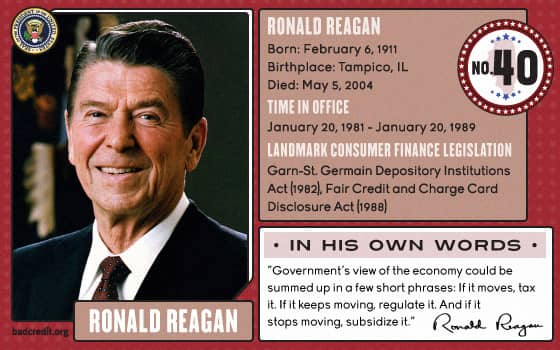
The term “trickle-down economics” is often associated with President Reagan, who advocated lower taxes for the wealthiest Americans and more economic deregulation. He also greatly expanded the military and its powers during a revitalized wave of patriotic nationalism towards the end of the Cold War.
When he wasn’t dodging assassination attempts and handling international crises, the “Great Communicator” found time to pass a pair of important consumer finance laws:
The Garn-St. Germain Depository Institutions Act (1982) — Garn-St. Germain deregulated banks and gave them the flexibility to offer more complex loan products, such as commercial and business loans.
It also lifted the interest rate caps for various loan products and allowed banks to start offering adjustable-rate mortgages, which allows interest on mortgages to change periodically according to market conditions, as opposed to staying the same as is the case with fixed-rate mortgages.
Fair Credit and Charge Card Disclosure Act (1988) — This Act largely overhauled how credit card companies present information about their cards in applications and solicitations.
For example, the Act requires credit card applications to clearly state the APR, fee schedule, terms and similar information about the card’s expenses to the consumer.
9. William “Bill” Clinton
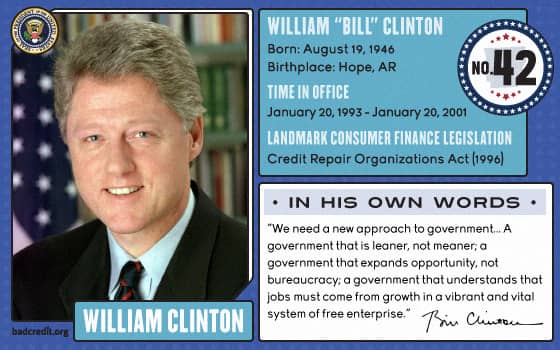
President Clinton oversaw powerful economic growth during the majority of his presidency, thanks in part to the newly drafted North American Free Trade Agreement (NAFTA) and the rise of information technology and internet commerce (which unfortunately resulted in the dotcom bubble around the turn of the millennium).
Most people remember Clinton for his welfare reform, an attempt at healthcare reform, and scandal involving a White House intern. However, many people may not remember an important piece of consumer legislation he passed.
The Credit Repair Organizations Act (1996) — Before CROA, credit repair businesses sometimes used misleading language and set unrealistic expectations to lure in consumers and their money.
“The Act prohibited companies from advising consumers to lie about their credit histories (a bad idea), unlawfully advising consumers to alter their identities, and charging in advance for this bad advice,” said David Friedman, Associate Professor of Law at Willamette University. “Credit Repair Organizations were also mandated to disclose to consumers their rights and disclose in their contracts with consumers how much the services would cost, what services would be performed, and the time frame for completion.”
However, many critics argue that President Clinton actually reduced consumer protections during his time in office by passing the Gramm-Leach-Bliley Act, which effectively repealed Glass-Steagall and allowed banks to participate in both commercial and investment activities.
“That allowed banks to engage in securities and insurance activity that had been previously prohibited,” Graham said. “Many people argue [the repeal] was a contributing factor to the Great Recession… it was an abject failure in terms of consumer finance protection.”
10. George W. Bush
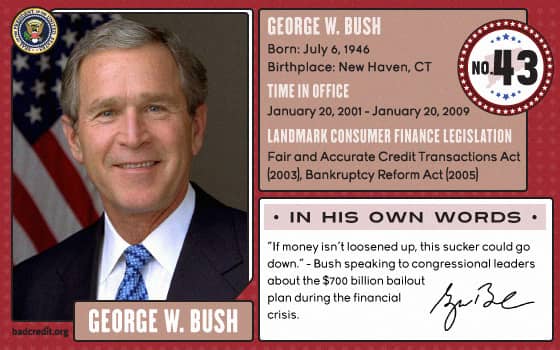
For a majority of his two terms in office, President Bush oversaw a period of exceptional economic growth in the United States — that is, until predatory lending practices plunged the nation in the subprime mortgage crisis and the Great Recession.
While he was more known for the PATRIOT Act and No Child Left Behind, President Bush also passed a few helpful consumer finance laws.
The Fair and Accurate Credit Transactions Act (2003) — FACTA was largely focused on helping consumers monitor their own credit report activity and cut down on cases of identity theft. For example, we are able to request a free credit report from the big three credit reporting bureaus (Experian, Equifax, Transunion) thanks to FACTA.
It also put guidelines in place that would make banks and lending institutions more transparent about their risk assessment of borrowers and encouraged new mechanisms to monitor and cut down on cases of identity fraud.
Ever notice how only the last few digits of your credit card show up on receipts? You can thank FACTA for that.
The Bankruptcy Abuse Prevention and Consumer Protection Act (2005) — The 2005 Bankruptcy Act made it much more difficult for individual debtors to file for chapter 7 bankruptcy by establishing a “means test,” which essentially requires the debtor to prove chapter 7, a massive liquidation of assets, is the only option.
It also required most applicants to go through a government-approved credit counseling program before filing and a financial management education program after filing. A reputable bankruptcy firm can help you with this process.
However, the legislation has its critics.
“The [2005 Bankruptcy Act] amendments represent the worst example of interest-group politics influencing law in the most negative way,” said Jason Kilborn, Professor of Law at John Marshall Law School. “Virtually every aspect of the over 600-page law made the bankruptcy process less efficient and less effective, mainly but not only for consumer debtors and the administrators of this system. No counter-reform is likely to fix the mess than BAPCPA has wrought, but a return to the law as of 2004 (with some minor exceptions relating to international practice, for example) would be a welcome and wholly appropriate step today.”
11. Barack Obama
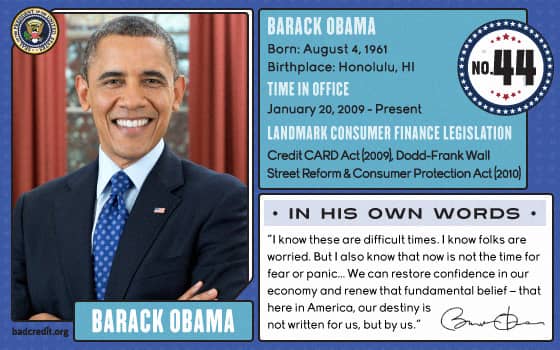
The one-term senator from Illinois had a lot on his plate from day one: the economy was in a tailspin from the subprime mortgage crisis, some of America’s biggest companies were going bankrupt virtually overnight and millions of citizens were losing their jobs.
The bailout initiated by President Bush helped to mitigate the hemorrhaging economy, but lawmakers realize they needed to put new laws in place to help avoid another Great Recession.
The Credit Card Accountability Responsibility and Disclosure (CARD) Act (2009) — Also known as the “credit cardholders bill of rights,” the Credit CARD Act addressed key transparency and fairness problems consumers faced in the credit card industry.
For example, the law prohibits lenders from increasing interest rates on existing balances due to reasons like “market conditions” or changes in the cardholder’s credit score. The law also mandates lenders be more transparent about fees they levy and ended a number of other confusing and subversive tactics used on cardholders.
“The credit card market pre-reform was dominated by the “tricks and traps” described by Senator Warren, and the regulatory improvements attacked much of the problem,” said University of Minnesota Associate Professor of Law Prentiss Cox. “Research has shown huge decreases in fees, especially late fees and over-balance fees, with no substantial increase in interest charges (or perhaps decreases).”
The Dodd-Frank Wall Street Reform and Consumer Protection Act (2010) — Dodd-Frank was arguably one of the significant pieces of financial regulation legislation in the history of the United States. The bill largely reformed the Federal Government’s oversight of the economy and created a slew of new agencies in the process, such as the Consumer Financial Protection Bureau, to help prevent another Great Recession.
Most important to consumers is Title XIV of Dodd-Frank, the Mortgage Reform and Anti-Predatory Lending Act. The section introduced new rules that prohibit predatory lending practices, such as balloon payments. It also greatly reduced the incentive for mortgage brokers to promote more expensive loans and increased oversight during the underwriting process.
“Despite howls of protest to the contrary, subprime mortgage lending is entirely possible under the new rules; it just has to comply with stricter lending requirements and review, which is appropriate, even essential,” Cox said. “It boggles the mind to see companies lobbying for a return to less regulated subprime mortgage lending… After what amounts to a nano-second in regulatory time, financial institutions are aggressively attacking many of the core Dodd-Frank reforms, including subprime mortgage protections.”
Advertiser Disclosure
BadCredit.org is a free online resource that offers valuable content and comparison services to users. To keep this resource 100% free for users, we receive advertising compensation from the financial products listed on this page. Along with key review factors, this compensation may impact how and where products appear on the page (including, for example, the order in which they appear). BadCredit.org does not include listings for all financial products.
Our Editorial Review Policy
Our site is committed to publishing independent, accurate content guided by strict editorial guidelines. Before articles and reviews are published on our site, they undergo a thorough review process performed by a team of independent editors and subject-matter experts to ensure the content’s accuracy, timeliness, and impartiality. Our editorial team is separate and independent of our site’s advertisers, and the opinions they express on our site are their own. To read more about our team members and their editorial backgrounds, please visit our site’s About page.




